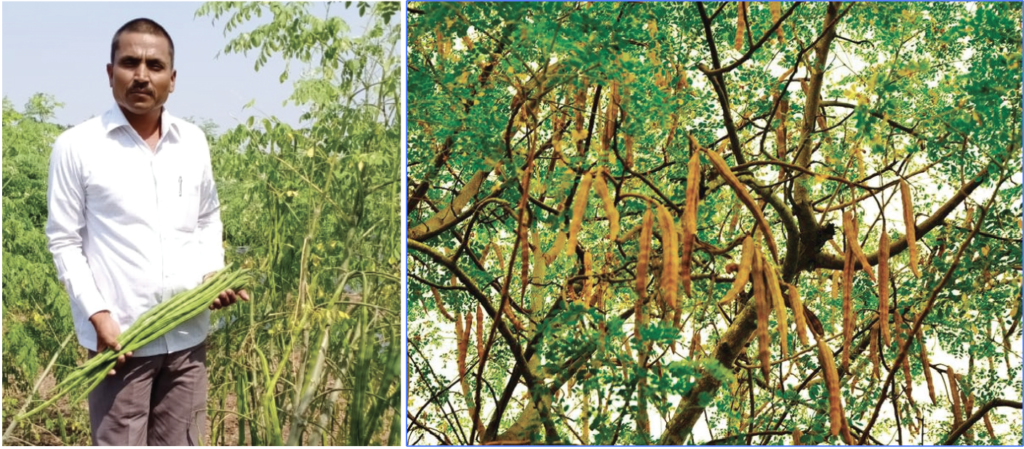If there was something called ‘nutrition storehouse’ in the plant world it would be Moringa oleifera or the drum stick tree, as it is commonly known. Each part of this ‘wonder tree’ is useful—the roots, stems, leaves, seedpods, resin and flowers.
Its generic name is derived from the Tamil word ‘murungai’ meaning ‘twisted pod’; and ‘oleifera’ is Latin, meaning ‘oil-bearing’, due to the high oil content of the seeds. Grown from seeds or propagated by a branch cutting, it hardly needs any irrigation. That is the reason it has been grown in large acreages in the drought-prone regions of Maharashtra, Tamil Nadu, Andhra Pradesh, Madhya Pradesh, Karnataka, West Bengal and Odisha.
This tree has been around for ages, but ever since the world at large claimed moringa as a superfood, thanks to its nutritional qualities, its acreage in the country’s arid and semi-arid zones have been rising as farmers recognise it as a crop that never fails despite climate change. This humble plant has been making strides in less-developed societies for thousands of years, and significant nutritional research has been conducted since the 1970s.
Moringa craze is sweeping the USA and countries in Europe, where health and wellness shops are stocked with biscuits, tea, cookies, chocolates, and muffins incorporating this plant. Indian food companies too have begun incorporating moringa into their products.
Though moringa has been part of the traditional Indian diet, the world at large discovered it when Time magazine touted it as “the next quinoa” in 2015 and the New Yorker in 2016 mentioned it as “a nutritional Swiss Army knife”. Other leading international publications too wrote gloriously about it, spreading awareness of the health benefits of moringa. Food and Agriculture Organization of the United Nations named it as the ‘crop of the month’.
Notably, a study published in the journal of the Federation of American Societies for Experimental Biology in 2017 found that its bioavailability (the amount that enters the body’s circulation) to be “very low”, but noted that it had exceptional anti-inflammatory extracts. Until recently, the much ignored moringa has acquired respectability among nutrition columnists in Indian media too. But sadly, it has yet to be a part of the mid-day meals food offered in schools. It may be noted that moringa contains argenine and histidine two amino acids especially important for infants, who are unable to make enough protein for their growth requirements.
In China, as a complement to medicinal plant resources, Moringa oleifera was introduced from India in the 1960s and had been cultivated on a large scale in Guangdong Province, Yunnan Province, and other areas since then. Additionally, moringa leaf was approved as a new food resource by the Chinese government in 2012.
Moringa provides a rich and rare combination of nutrients, amino acids, antioxidants, anti-ageing and anti-inflammatory properties used for nutrition and healing. Moringa leaves have seven times the Vitamin C of oranges, four times the calcium of milk, four times the vitamin A of carrots, three times the potassium of bananas, and double the protein of yoghurt. With over 92 nutrients and 46 natural antioxidants, as well as anti-inflammatory compounds it has been dubbed the ‘miracle tree’. Additionally, moringa oil harvested from the pods is much sought after in the formulation of skin care products.
A 2016 study by Malaysian researchers on animals found that the aqueous fraction of moringa contains Vicenin-2 active compound, which may accelerate wound healing in hyperglycemic condition. Diabetic foot ulcer is a serious complication of diabetes, which affects a significant percentage (15%) of diabetics and up to 15%–24% of those affected may require amputation.
“Moringa needs minimum care, and if grown in large areas it can fetch a good price from markets like Mumbai, Hyderabad or Chennai,” says software engineer Thangaraj Nadar, whose firm Indian Agro has tied up with a Malaysian company to sell moringa seeds and leaf powder. He planted the moringa’s PKM 1, PKM 2 and ODC varieties on his 20-acre ancestral plot in Karungulam village in Tamil Nadu’s Nagercoil district; they have since been harvesting 20-25 tonnes of drumstick pods per acre every year.
It’s a rare horticulture crop which begins fruiting within six months of planting and continues to do so for eight or nine years. Its lengthy pod is rich in calcium and other minerals, a must-add ingredient to sambar. It is also used as a vegetable.
Names like PKM 2, Bhagya KDM 1, Rohit 1, Siddhi Vinayaka…. may not ring a bell among urban readers, but those engaged in subsistence farming will recognise these as the high-yielding varieties of Moringa oleifera.
The drought-prone Saurashtra region in Gujarat, too, is enthusiastically embracing the moringa — farmers in Bhavnagar, Junagadh, Morvi and Rajkot now favour this tree known for its gnarly trunk and thick foliage. Agripreneur Neetu Patel of Atkot village in Rajkot has motivated over 1,200 farmers to cultivate moringa in their combined holding of 1,200 acres. Her firm, Satyam Enterprises, provides saplings, holds farmer workshops, trains them in making organic fertilisers and, above all, has a buy-back agreement with them for the produce — namely leaves, seeds, greenwood and so on. Among her customers are names like Patanjali Ayurved, Himalaya Drug Company and Zandu Pharmaceuticals.
Meet the moringa growers from Sangli, Solapur, Nashik, Pune, and Yavatmal, who thanks to video streaming platforms and messaging groups, have enhanced their livelihoods by catering to growing urban demands. As per the Journal of Pharmacognosy and Phytochemistry 2018 report it was found that moringa farms incurred an expense of ₹1 to accrue the benefit of ₹2.99. Hence, with low cost of investment and returns in the same year of cultivation, the drumstick is an economically viable crop.
Moringa is presently traded in several vegetable markets across Maharashtra, in Pune, Vashi, Solapur, and Aurangabad. This season, the rate for the drumsticks is between ₹3,500 – ₹4,000 per quintal.
Farmer Appa Karmakar is a successful moringa grower. His three-acre farm at Angar village in Solapur, which has a sparse vegetative landscape has become a go-to destination for arid zone farmers arriving from Gujarat, Madhya Pradesh, Uttar Pradesh, Telangana and Andhra Pradesh. Among the early adaptors of moringa, Karmakar, who holds a postgraduate degree, started cultivating moringa in 2012. He grows it with an intercrop of chillies, papaya, pomegranate and guava, besides marigold, which has been traditionally used to control pests. His farm produces 50 tonnes of drumsticks every year, selling for ₹ 30 to ₹ 80 per kg in the wholesale market and fetching approximately ₹ 6 lakh a year. His climate-smart horticulture improvisations with minimum inputs getting good returns attract farmers, journalists, agricultural graduates and agriculture experts to his farm.
According to Adinath Chavan, editor of Agrowon, a popular Marathi farm daily, farmers of Solapur like other inhabitants of State’s driest zone are likely to continue growing moringa as long as it offers good returns.


 [/column]
[/column]